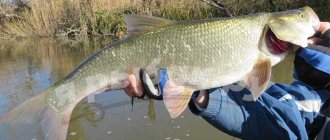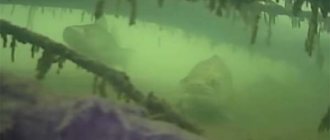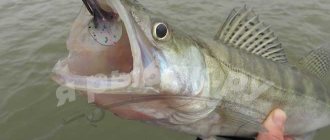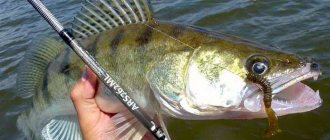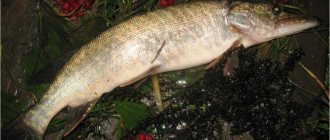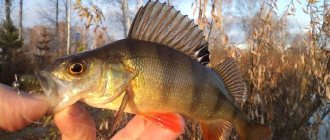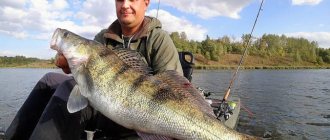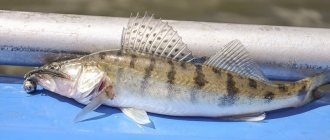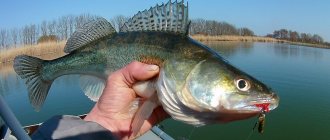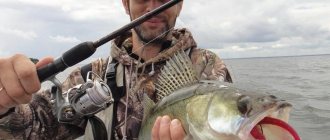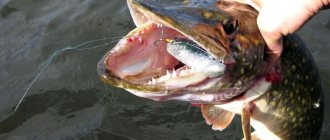Fishing for pike perch in September using a spinning rod
Fishing for pike perch in September is the most enjoyable of the entire autumn period.
Near the shore there are still plenty of schools of small fish, for which a hungry predator can go hunting. It is in September that you can fish in the fall from the shore. The rest of the time you should prefer fishing by boat. They fish day and night, since it is in the dark that this robber goes hunting. The nights are not yet too cold, and the time for nasty drizzling rains that can cause a cold in just one night has not yet come. When fishing with a spinning rod, two types of baits for pike perch are used - jig baits and wobblers. Sometimes rattlins are used, but these baits are more suitable for pike and other types of fish. Jig baits are divided into two types: those that have their own game and passive jig baits that require a certain intermittent retrieve. The latter show their best side, but are more demanding on the fishing gear and qualifications. This is interesting: Coastal fishing for pike perch with live bait
When fishing with jigs in September, it is best to use worms and foam fish. Preference is given to those that have a fluorescent color that glows in the light of an ultraviolet flashlight. Foam rubber with this color is quite difficult to find on sale, but worms are found in large quantities.
The nature of hunting and biting of pike perch is quite violent. This is not an ambush predator like pike. Small fish hunt in schools, chasing fish and using full-fledged hunting tactics, like perch. The large one catches prey alone, relying on its experience and large mouth, from which it is difficult for the fish to escape. Often he grabs prey not with his mouth, but by leaning on it with his muzzle, and bites occur on the chin.
The usual prey for pike perch is a small fish with a narrow body, such as a gudgeon, bleak or ruff. In the autumn, bleak, verkhovka and other small things begin to move to depth. However, in September it rarely moves far from the coastal zones, and pike perch follows it to the water’s edge. During the daytime, it is extremely shy and rarely feeds, and can be found in the shadows of bridges, canopies, under piers and embankments at great depths, under bushes hanging over a deep pool, in deep holes under snags - anywhere where sunlight does not penetrate. The little thing likes to stand in the same places, but not so deep, and in the evening he comes out after it.
When fishing from a boat, you should look for shallows near deep holes. He will stand in the pits during the day, going out to the shallows at night. When searching for fish, an echo sounder provides serious assistance. With its help, you can easily find large accumulations of small items. Usually these are bream or roach, which are of less interest to pike perch than bleak or minnow. However, it is quite possible that there is a flock of bug-eyed predator on the echo sounder screen, for which you can start hunting with a spinning rod.
Fishing with live bait
Fishing with live bait in October is usually practiced by those who catch burbot. This can be fishing with a line, with a donk with an elastic band, or with a cast. It is worth remembering that most live bait does not tolerate long-distance casting of the bottom into the water and may simply die due to concussion. Fish are reluctant to take such dead bait. Therefore, a net and an elastic band are suitable for live bait bottom fishing. They allow you to deliver live bait to depth smoothly, without dizzying flights through the air followed by a blow.
When fishing this way, most often the catch will be burbot. But you can also successfully catch pike perch if you set the line so that most of the hooks go along its path, discovered earlier. There is a chance that when checked, all of them will be hung with valuable fanged trophies and no less valuable with a mustache on their chin.
Sometimes, especially in areas rich in fish, in Astrakhan, in Akhtuba, in the lower reaches of the Volga, you can see autumn fishing for pike perch with mugs. Of course, if you have a boat. Practice in more northern regions shows that pike often take to circles, and best of all in the summer, not pike perch in autumn. However, if you have free time, you can try this method of live bait fishing. An echo sounder in a fisherman’s arsenal has long made mugs not as effective as a spinning rod. It allows you to purposefully follow a school of fish, rather than wait for a bite along a wide front of spaced circles. And you’ll have to chase them all over the lake, exhausted behind the oars or the roar of the engine.
Fishing for pike perch in October using a spinning rod
Walleye are becoming more active as the nights get longer and there is more time to hunt.
It is caught best during evening twilight. In northern latitudes they are long, which helps the angler catch more fish. Catching it can take place both at night and in the morning, but it is most successful after sunset. Burbot, if there is one in the reservoir, can also become prey for a spinning angler in October, and pike begin to take jigs closer to the morning, but in this case it is necessary to use different wiring and equipment. When fishing with jig, it helps to achieve success by moving the passive bait in a shallow step with periodic twitching in long, frequent pauses. The drop-shot rig with a special side hook performs well. It allows you to fish even with a not very loud rod on passive baits, twitching them in one place and transmitting even small vibrations to them without moving the sinker. Such a game irritates the pike perch, which is passive, and forces it to rush to the bait. In addition, playing with a bait that hits the bottom in one place allows you to find it faster in the dark than one that moves.
When fishing with spinners, you should use front-loaded or jig spinners, and only in some cases - classic “lon” spinners. It’s even better to fish with bosoms, since they, unlike “kopecks,” create stronger vibrations that imitate not a fry, but a single small fish. It is also worth paying attention to clampless turntables and petals with holes for the same reason. The petal should have a fluorescent color, so you should buy a more expensive lure, or then stick on special glitter.
Wiring with a wobbler should be near the bottom, as slowly as possible. It is very important to use sufficiently loud fishing rods and braided cord. In the dark, it is very difficult to notice a bite on the fishing line, and you have to navigate with your hands. Also, a good fishing rod with a cord will show when the spoon clings to the bottom, when it stops playing, when the retrieve should be accelerated or slowed down, and, of course, will indicate a pike perch bite. In general, using a line in night fishing is the only correct way, but it entails an increase in the cost of the gear, since it requires a good reel, a good fishing rod with high-quality rings.
Jig fishing
The most popular way of catching autumn pike perch among spinning anglers. It is used throughout the fall - in September, October and November. They practice fishing with silicone fry, brooms, silicone crayfish, mandula, and jig spinners. They fish with a classic jig loaded with a Cheburashka and with a drop-shot rig, which helps fish the pike perch holes centimeter by centimeter, finding a passive pike perch and forcing it to bite. Heads are used relatively rarely, since they involve more uniform wiring in the water column, and not playing with a knock on the bottom.
Fishing for pike perch in November using a spinning rod
Ice is already rising in many areas, and fishing is becoming less and less comfortable.
Be sure to take gasoline-powered winter heating pads with you when fishing, a thermos with warm tea in the boat, and a warm fire should be waiting for the fisherman on the shore so that he can come up and warm up. Pike perch bite almost exclusively from the depths. They use both jig fishing and vertical fishing with spinners and balancers. Fish are increasingly starting to catch during the day. There is an interesting pattern regarding the fall bite of pike perch. In most reservoirs, October is the peak of its activity. Then, from mid-October to mid-November, there is a certain decline. There is a period when it is almost impossible to catch it for a whole week in November, and this repeats from year to year. The bite gets better after the first ice.
Pike perch prey is inactive at this time. It takes less activity when it runs away, since the fish's metabolism is slower in cold water. Therefore, you need to use increasingly slower retrieves, longer pauses, and more often use drop-shot rigs. However, bites can be frequent and active, as pike perch gather in large schools before wintering. An echo sounder in November is more important than ever; it is most likely to find a concentration of pike perch with it. Read also: With sprat for pike perch
It is almost impossible to catch from the shore at this time, and those who do not have a boat should wait until the ice freezes and only then go out for pike perch. However, when fishing with a spinning rod, perch can produce a good bycatch. In November, this fish approaches the coastal zone and catches the remaining fry right near the ice edge, clearing space for itself before wintering and fattening up. They catch during the day using active jig baits with a retractable leash, drop-shot rigs, and wobblers.
Weather matters when fishing for walleye. For example, it is not worth catching it at a time when it is constantly raining. It does not respond well to prolonged deterioration of the weather. On the contrary, when the weather is clear during the day and the sun is shining, you can go out for pike perch closer to sunset. You can also expect an improvement in the bite if, after a clear sun, clouds appear in the sky, but there is no heavy rain or wind.
There is a close relationship between the activity of pike perch and the phases of the moon. It has been noticed that this fish is often more active during the full moon. On the contrary, during periods when there is no moon in the sky, it shows no interest in the bait at all, and only its flocks located in the hole can be observed on the echo sounder screen. It is possible that the full moon usually coincides with anticyclonic weather and bright sun during the day, and on the new moon there is usually a strong wave, wind and rain, and the pike perch is in a depressed state at this time.
Atmospheric pressure must also be taken into account. It is noted that with increasing atmospheric pressure there is more oxygen in water. This is usually observed during the transition from anticyclone to cyclone, that is, from good weather to bad. This may explain the improved bite during short-term, but not too prolonged rain.
Spinning rod for catching pike perch
Spinning rods for fishing should be designed for comfortable night fishing. The rod itself should be light. This will not scare away the fish, but it is easier to break a dark rod in the dark than a white one. It is not recommended to paint the blank with varnish, as this can significantly change the structure of the rod for the worse. As already mentioned, when fishing for pike perch, a braided cord is used, and the rings must be of high quality so that it does not deteriorate.
When fishing for pike perch, the reel should also be at a high level. Size 1500-2000 according to Shimano classification. You can use heavier ones, but this will completely kill all the pleasure of fishing, where a light rod with a small reel allows you to feel all the resistance of the fish.
Those who fish with fairly heavy heads can use a multiplier. This is more practical than big non-profits. The cartoon will help you perform better wiring and is better suited for fishing from a boat. But it is not suitable for casting small Cheburashkas, and you cannot fish with light spinners with it at all. The most suitable cartoon for jig fishing is a small soap dish weighing 200-300 grams with a wide braking range. With this you can comfortably throw loads of 10-15 grams.
The spinning rod must be of suitable length. It greatly depends on the wiring technique used by the spinner. The size of 2.4 meters should be considered universal; it is suitable for both shore fishing and for a boat.
Particular attention should be paid to the balance of the rod. When fishing, the hand that holds the rod should be slightly below the reel, and the center of gravity of the entire tackle should also be there. This is necessary because when playing with an active bait you will have to work often and a lot with the tip of the rod. If your balance is poor, your hand will get very tired. You can correct the balance by slightly sharpening the handle.
The most convenient type of spinning rod handle for jigging is skeleton. This handle can be found on some kaida models in the mid-price range. They suffer from bad tips that can break, so you need to check them when purchasing by lightly resting the tip on the ceiling with the consent of the seller. If your budget is limited, then Kaida Phineas and Swagger are an excellent choice for catching pike perch with not very heavy baits. If you are lucky with the quality, you can fish for many years and be happy.
For those who have enough money for a good spinning rod, we can recommend a Silverado 742 ml stick for jig fishing for pike perch, which has a better test range, ringing and casting qualities, but also a better price. This stick is suitable for both inertia-free and small cartoons.
Features of catching autumn pike perch
Technician
Administrator
Autumn fishing for pike perch starts in late August, early September. From these months until the first frost, you can successfully catch pike perch not only during the day, but also at night. The main advantage of night fishing for pike perch with a jig is that there is no noise, which has a positive effect on the activity of the predator.
In autumn, pike perch sticks to deep areas of the reservoir and this is important to know, since the choice of bait for catching pike perch will depend on this. At the end of September, pike perch begins its autumn feeding season, a time when the predator indiscriminately attacks everything that swims past it. The duration of the zhora depends on weather conditions, but, as a rule, it is no more than 30 days. Many anglers claim that mid-autumn is the period when there is an opportunity to catch the largest trophy.
However, it is worth noting that the autumn feeding of pike perch is much weaker than the pre-spawning one, but if it is possible to find a place where the predator is staying, then the capture of the trophy will depend only on the skill and personal skills of the fisherman. As for the baits with which predators are caught, not only jigs are used, but also paralons and even small oscillating spoons. In November, the activity of pike perch decreases, but a week before the start of freeze-up it can increase again. It is important to note that during this period only large pike perch, whose weight exceeds 1 kg, bites. The activity of fish depends on such natural factors as: direction and strength of wind, atmospheric pressure, air temperature, etc. In order to successfully catch pike perch in the fall, it is important to choose the right fishing technique, which we will discuss further.
How to properly catch pike perch in the fall using a jig
Fishing with a jig involves performing a stepwise retrieve. It is important to immediately note that the bait must always be on the bottom. When you turn the reel or twitch the tip of the rod, the bait comes off the bottom to a height of approximately 10 cm, after which it sinks to the bottom again. Posting is carried out until the bait reaches the fishing point. What are jig baits? Lures of this type include silicone vibrotails, twisters, and paralon fish. In autumn, it is recommended to select bait with a body size that does not exceed 10 cm. When choosing a jig head in relation to weight, it is important to take into account the strength of the current in the fishing area, as well as the depth. Provided that the weight is correctly selected, after casting the bait will be completely controlled during retrieval, which will allow you to timely notice the bite of a predator, which is expressed in a light blow, similar to a hook.
In order to successfully fish, choosing the right bait and determining the fishing location will not be enough. It is very important to choose and set up the right tackle for catching pike perch. The length of the spinning rod is selected based on the fishing conditions. So, when fishing from the shore, it is recommended to use a rod with a length of at least three meters; from a boat, a length of 2.7 meters will be sufficient. The reel that will be installed on a spinning rod for catching pike perch in the fall must have a front drag and, most importantly, must be light. Wrap a regular fishing line with a diameter of 0.2 mm on a mono spool, the pike perch will not bite through it. However, it is important to know that the fishing line has the ability to stretch, which does not allow proper control of the bait during retrieving. Therefore, it is better to use a Power Pro braided cord, which, with a smaller diameter, is more durable, does not have the ability to stretch and provides the tackle with increased sensitivity, which allows you to notice the slightest touch on the bait.
Video
Autumn fishing for pike perch on a jig video
Excellent Cool. Worthy Catch! Video from “Fishing with Romario Agro”
Features of catching pike perch in late autumn video
Pike perch has always been a desirable trophy for any angler. Volga pike perch in the Samara region remains active almost all year round, but catching it is not as easy as it might seem at first glance. Autumn is undoubtedly the best time to hunt pike perch, which begins to feed around the end of October.
